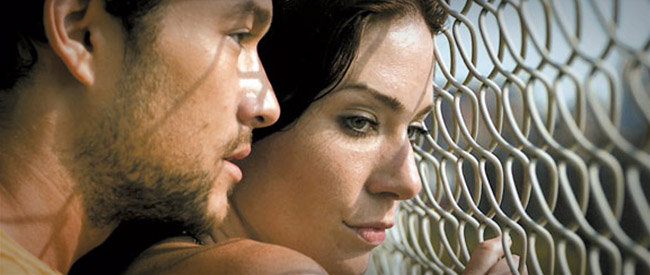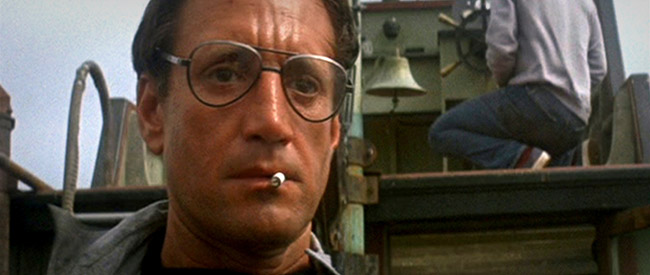Old v. New: The Contrasting Technology and Threats of ‘Jaws’ and ‘Uncertainty’
In our regular feature Old v. New, Kimberly Marcela Duron compares a newer independent release with an older classic to see what similarities they share, how they diverge and hear what the conversation between the two films says about filmmaking as the art form continues to innovate and evolve.
***
If you live in Los Angeles, chances are you’ll admit that a West Coast summer is one of the best summers you can possibly have. But that said there’s no denying that our East Coast cousins have used the coastal Atlantic region as the setting for some extremely memorable summer-themed movies. So as July 4th approaches with the promise of outdoor barbecues and skies lit up by nighttime fireworks, this month’s Old v. New pauses to examine two vastly different East Coast-set films that depict a much more exciting—and dangerous—vision of Independence Day weekend gone awry.
Arguably the most iconic summer thriller is 1975’s Jaws, directed by Steven Spielberg, about a small beach town threatened by an insatiable great white shark—which just so happens to appear during the town’s peak weekend for tourism. Despite a troubled production that included art department malfunctions, budget overruns and missed deadlines, I think it’s safe to say that the film ended up doing pretty well.
Almost 40 years later, the writing/directing duo of Scott McGehee and David Siegel created another type of summer suspense thriller; one set far, far away from the beach resorts of Martha’s Vineyard in the urban jungles of New York City, called Uncertainty (2008). As the title suggests, the film explores the relationship of one young couple struggling to make a difficult decision. Told via dual storylines, the film toggles back and forth between being either A) a crime thriller set in Chinatown, or B) a Brooklyn-set family drama.
So: as film continues to evolve into digital, and as digitally shot films are exhibited most often on a 17-inch VOD screen, are there still traces of classical filmmaking influences to be found in modern indie film? Like, how does a high-concept 1975 thriller relate to a 2008 conceptual low-budget independent? While the filmmaking style varies greatly between Jaws and Uncertainty the way each film approaches their depiction of their respective threats, protagonists and approach to problem solving shows remarkable similarities.
https://www.youtube.com/watch?v=a8hQnM7S-Io
“Man versus creature” is the textbook protagonist/antagonist storyline that defines Jaws. Spielberg’s film poses the question, what happens when a cop who’s afraid of the water must do battle with a giant shark? This is the question that makes Jaws a high-concept film. It’s ironic that small-town Amity’s Police Chief (Roy Scheider) is so fundamentally ill-equipped to fight his enemy, so the stakes are pretty high. To top it all off, Amity’s Mayor isn’t helping the Chief do his job, because hey… tourism money.
On the other hand, Uncertainty is a bit harder to define, first and foremost because there are two what-if storylines. In its crime thriller version, Uncertainty is certainly a “man vs. man” film; the first “man” being Bobby and Kate (Lynn Collins and Joseph Gordon-Levitt) and the second being the Chinese assassin who keeps showing up to kill them over a very bad 4th of July weekend. In its family drama half, however, Uncertainty seems to portray the antagonist as a loving, Argentinean-immigrant mother in Brooklyn with high hopes for her daughters. But the ultimate reveal is that neither the guy with the gun (storyline A) nor the concerned mother (storyline B) aren’t the actual force Bobby and Kate are up against. Rather, it’s the dark and heavy cloud of big decisions that Bobby and Kate haven’t been able to resolve. So in this respect, the film’s conflict is… man versus self?
With ambiguous conversations reminiscent of Ernest Hemingway’s short story “Hills Like White Elephants” both of the Uncertainty’s storylines centering on the decision of whether or not to (spoiler alert!) keep the 11-week-old baby in Kate’s belly. See? Not quite as easy logline to churn out as one involving a killer shark.

In Jaws, Spielberg wants the audience to get the maximum of “climax” possible, changing the end of the original Peter Benchley novel from the shark’s death coming via multiple wounds to a more spectacular demise by pressurized scuba tank obliteration.
Uncertainty resolves each of its dueling storylines with each scenario’s Bobby and Kate posing the question: “So what do we do now?” The answer in both cases is an almost existential: “I guess we just keep going.” The ending of Jaws is—let’s be honest—more satisfying, but Uncertainty’s feels much more authentic, regardless of situation.
Fun fact: after testing a few different DSLRs, Uncertainty filmmakers McGehee and Siegel opted for an Arriflex D-20, a digital camera that resembles a 35mm film camera in field of view and depth of field. Four decades ago, Spielberg and his cinematographer Bill Butler used a couple different Panavision 35mm film cameras to shoot Jaws. This may sound like I’m trying to prove the Illuminati theory here, but stick with me: deliberate color usage is another major commonality shared by both films.
Jaws, which takes place mostly on or nearby the water, is full of blues and duller warm colors so that the red in gore scenes really pops. In Uncertainty, green and yellow are used to identify each storyline—green being the more peaceful/normal “drama” scenario and the yellow being the erratic, unpredictable “thriller” one.

When I first watched Jaws I remembered thinking, what kind of underwater camera did they use? Fact is, Butler actually created a glass box that could be submerged into the 35-foot-deep waters of the actual Atlantic Ocean—kind of like the OG GoPro case. Fast forward to a 2008 Manhattan subway station, where McGehee and Siegel had to switch out their Arris for certain scenes because “film-crew-inserting-different-colored-cables-and-batteries-into-a-heavy-machine” is not exactly the best way to divert attention away from an unpermitted film shoot (the filmmakers ended up using a far more discrete Super 16mm.)
So despite changes in technology, filmmakers will still adapt to their environments to preserve the core of their creative vision. Whether a high-concept blockbuster or a more complex indie movie, production aspects like cinematography and performance in both Jaws and Uncertainty help illustrate the timeless themes of conquering your fear and/or discovering that no matter what decision you make, life always goes on. Talk about fireworks!
